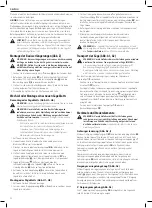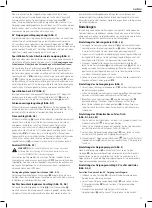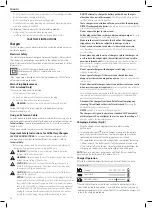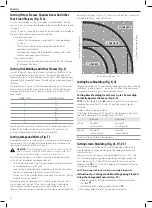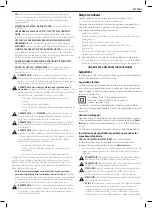
45
EnGLIsh
Battery Packs
Important Safety Instructions for All Battery Packs
When ordering replacement battery packs, be sure to include catalogue
number and voltage.
The battery pack is not fully charged out of the carton. Before using the
battery pack and charger, read the safety instructions below. Then follow
charging procedures outlined.
READ ALL INSTRUCTIONS
•
Do not charge or use battery in explosive atmospheres, such as
in the presence of flammable liquids, gases or dust.
Inserting or
removing the battery from the charger may ignite the dust or fumes.
•
Never force battery pack into charger. Do not modify battery pack
in any way to fit into a non-compatible charger as battery pack
may rupture causing serious personal injury.
• Charge the battery packs only in
D
e
WALT
chargers.
•
DO NOT
splash or immerse in water or other liquids.
•
Do not store or use the tool and battery pack in locations where the
temperature may fall below 4 ˚C (34 ˚F) (such as outside sheds or
metal buildings in winter), or reach or exceed 40 ˚C (104 ˚F) (such
as outside sheds or metal buildings in summer).
•
Do not incinerate the battery pack even if it is severely damaged
or is completely worn out.
The battery pack can explode in a fire.
Toxic fumes and materials are created when lithium-ion battery packs
are burned.
•
If battery contents come into contact with the skin, immediately
wash area with mild soap and water.
If battery liquid gets into the
eye, rinse water over the open eye for 15 minutes or until irritation ceases.
If medical attention is needed, the battery electrolyte is composed of a
mixture of liquid organic carbonates and lithium salts.
•
Contents of opened battery cells may cause respiratory irritation.
Provide fresh air. If symptoms persists, seek medical attention.
WARNING:
Burn hazard. Battery liquid may be flammable if exposed
to spark or flame.
WARNING:
Never attempt to open the battery pack for any reason. If
battery pack case is cracked or damaged, do not insert into charger.
Do not crush, drop or damage battery pack. Do not use a battery pack
or charger that has received a sharp blow, been dropped, run over
or damaged in any way (i.e., pierced with a nail, hit with a hammer,
stepped on). Electric shock or electrocution may result. Damaged
battery packs should be returned to service centre for recycling.
WARNING: Fire hazard. Do not store or carry the battery pack so
that metal objects can contact exposed battery terminals.
For
example, do not place the battery pack in aprons, pockets, tool boxes,
product kit boxes, drawers, etc., with loose nails, screws, keys, etc.
CAUTION: When not in use, place tool on its side on a stable
surface where it will not cause a tripping or falling hazard.
Some
tools with large battery packs will stand upright on the battery pack
but may be easily knocked over.
Transportation
WARNING: Fire hazard.
Transporting batteries can possibly cause
fire if the battery terminals inadvertently come in contact with
conductive materials. When transporting batteries, make sure that the
battery terminals are protected and well insulated from materials that
could contact them and cause a short circuit.
NOTE:
Lithium-ion batteries should not be put in checked baggage.
D
e
WALT
batteries comply with all applicable shipping regulations
as prescribed by industry and legal standards which include UN
Recommendations on the Transport of Dangerous Goods; International Air
Transport Association (IATA) Dangerous Goods Regulations, International
Maritime Dangerous Goods (IMDG) Regulations, and the European
Agreement Concerning The International Carriage of Dangerous Goods by
Road (ADR). Lithium-ion cells and batteries have been tested to section 38.3
of the UN Recommendations on the Transport of Dangerous Goods Manual
of Tests and Criteria.
In most instances, shipping a
D
e
WALT
battery pack will be excepted
from being classified as a fully regulated Class 9 Hazardous Material. In
general, only shipments containing a lithium-ion battery with an energy
rating greater than 100 Watt Hours (Wh) will require being shipped
as fully regulated Class 9. All lithium-ion batteries have the Watt Hour
rating marked on the pack. Furthermore, due to regulation complexities,
D
e
WALT
does not recommend air shipping lithium-ion battery packs alone
regardless of Watt Hour rating. Shipments of tools with batteries (combo
kits) can be air shipped as excepted if the Watt Hour rating of the battery
pack is no greater than 100 Whr.
Regardless of whether a shipment is considered excepted or fully regulated,
it is the shipper's responsibility to consult the latest regulations for
packaging, labeling/marking and documentation requirements.
The information provided in this section of the manual is provided in good
faith and believed to be accurate at the time the document was created.
However, no warranty, expressed or implied, is given. It is the buyer’s
responsibility to ensure that its activities comply with the applicable
regulations.
The compatible charger(s) will not charge a faulty battery pack. The charger
will indicate faulty battery by refusing to light.
nOTE:
This could also mean a problem with a charger.
If the charger indicates a problem, take the charger and battery pack to be
tested at an authorised service centre.
hot/Cold Pack Delay
When the charger detects a battery pack that is too hot or too cold, it
automatically starts a Hot/Cold Pack Delay, suspending charging until the
battery pack has reached an appropriate temperature. The charger then
automatically switches to the pack charging mode. This feature ensures
maximum battery pack life.
A cold battery pack will charge at a slower rate than a warm battery pack.
The battery pack will charge at that slower rate throughout the entire
charging cycle and will not return to maximum charge rate even if the
battery pack warms.
The DCB118 charger is equipped with an internal fan designed to cool
the battery pack. The fan will turn on automatically when the battery pack
needs to be cooled. Never operate the charger if the fan does not operate
properly or if ventilation slots are blocked. Do not permit foreign objects to
enter the interior of the charger.
Electronic Protection system
XR Li-Ion tools are designed with an Electronic Protection System that
will protect the battery pack against overloading, overheating or deep
discharge.
The tool will automatically turn off if the Electronic Protection System
engages. If this occurs, place the lithium-ion battery pack on the charger
until it is fully charged.
Wall Mounting
These chargers are designed to be wall mountable or to sit upright on a
table or work surface. If wall mounting, locate the charger within reach of an
electrical outlet, and away from a corner or other obstructions which may
impede air flow. Use the back of the charger as a template for the location
of the mounting screws on the wall. Mount the charger securely using
drywall screws (purchased separately) at least 25.4 mm long with a screw
head diameter of 7–9 mm, screwed into wood to an optimal depth leaving
approximately 5.5 mm of the screw exposed. Align the slots on the back of
the charger with the exposed screws and fully engage them in the slots.
Charger Cleaning Instructions
WARNING: Shock hazard. Disconnect the charger from the AC
outlet before cleaning
. Dirt and grease may be removed from the
exterior of the charger using a cloth or soft non-metallic brush. Do not
use water or any cleaning solutions. Never let any liquid get inside the
tool; never immerse any part of the tool into a liquid.
Содержание DCS727
Страница 1: ...Final Page Size 172 x 240 mm DCS727 ...
Страница 4: ...2 Fig D Fig C Fig B Fig E Fig F 41 42 5 4 61 4 5 39 68 40 36 ...
Страница 5: ...3 Fig G Fig H4 Fig I Fig H1 Fig H2 Fig H3 1 44 1 43 31 21 22 19 51 49 50 46 43 45 31 48 47 ...
Страница 6: ...4 Fig N Fig O1 Fig L Fig M Fig K 21 21 60 62 Fig J 10 59 52 53 54 55 56 57 58 ...
Страница 7: ...5 Fig O2 Fig Q Fig S Fig P Fig T Fig R 2 1 A 1 2 ...
Страница 8: ...6 Fig X1 Fig W1 Fig W1 Fig V2 Fig V1 13 46 17 13 46 13 13 17 Fig U ...
Страница 9: ...7 Fig X2 Fig Y Fig AA Fig Z 1 63 64 15 16 66 65 67 ...


